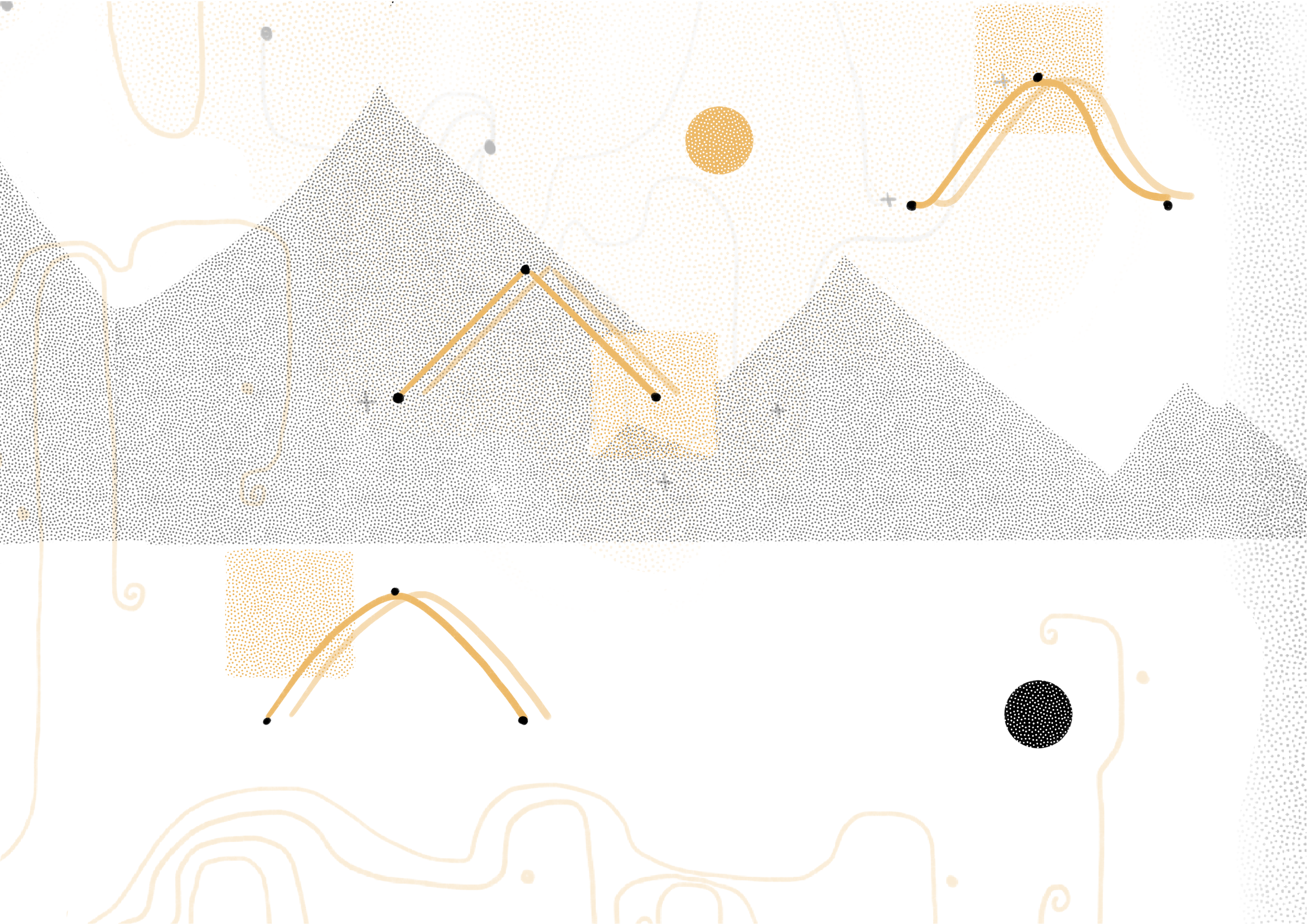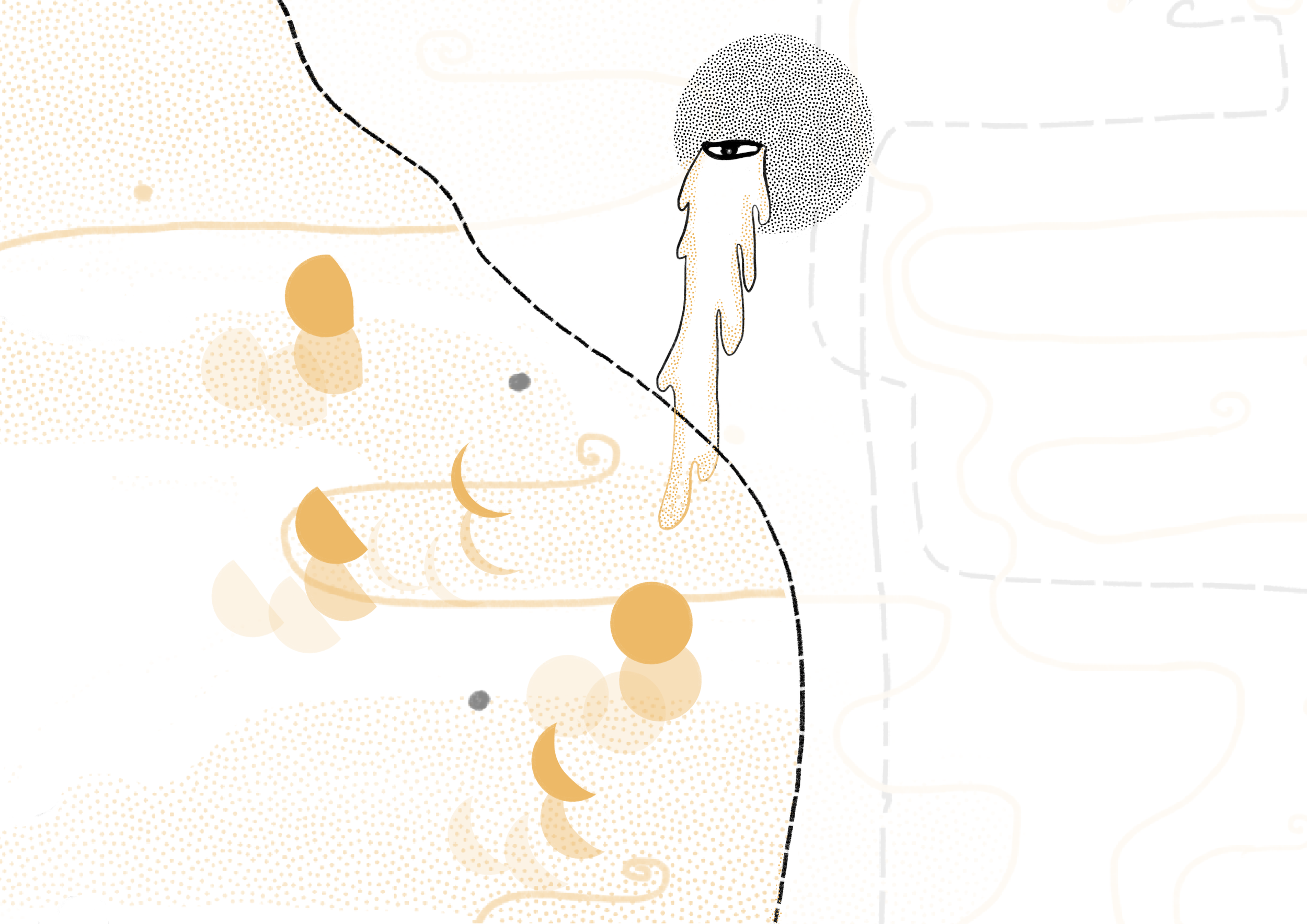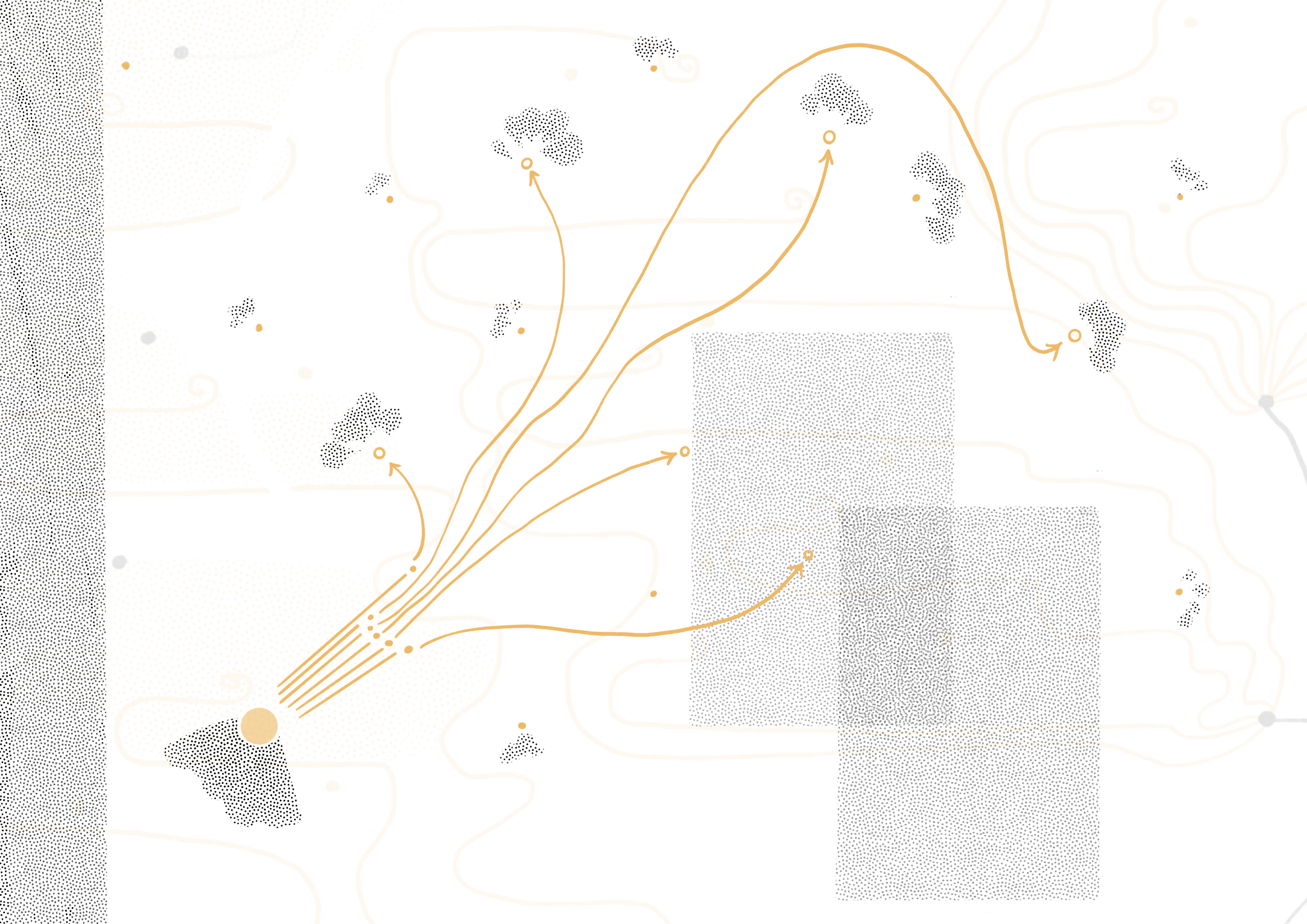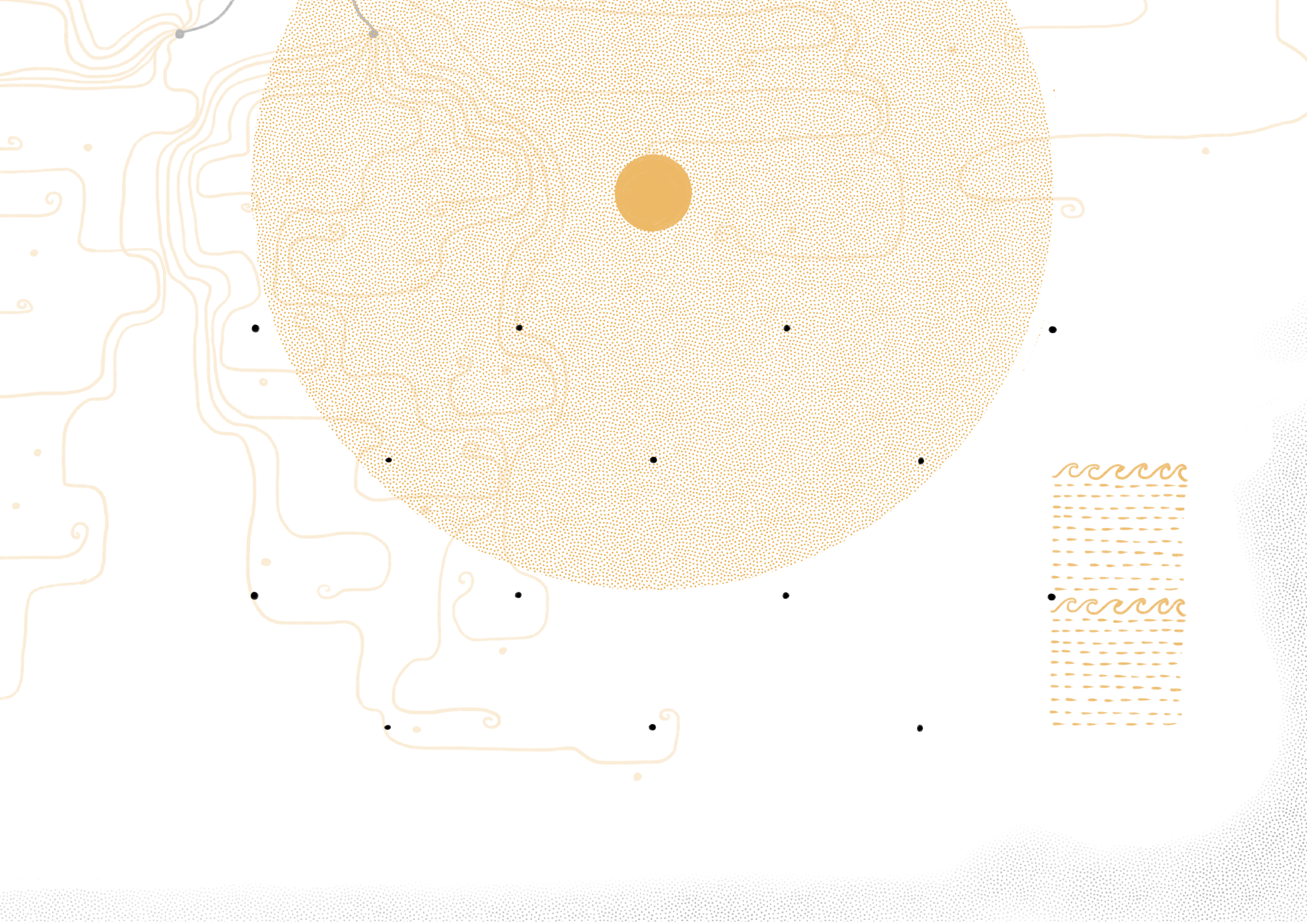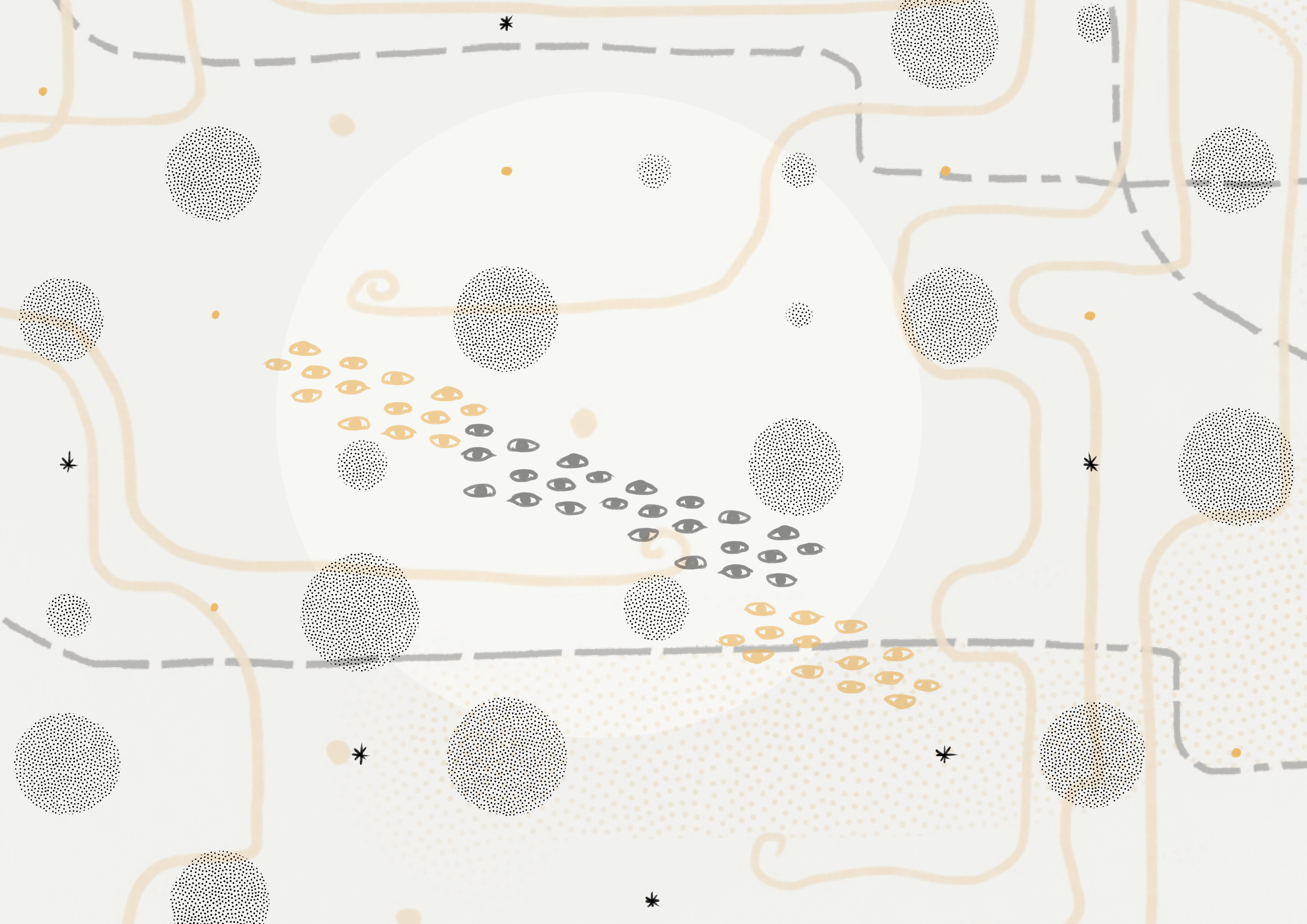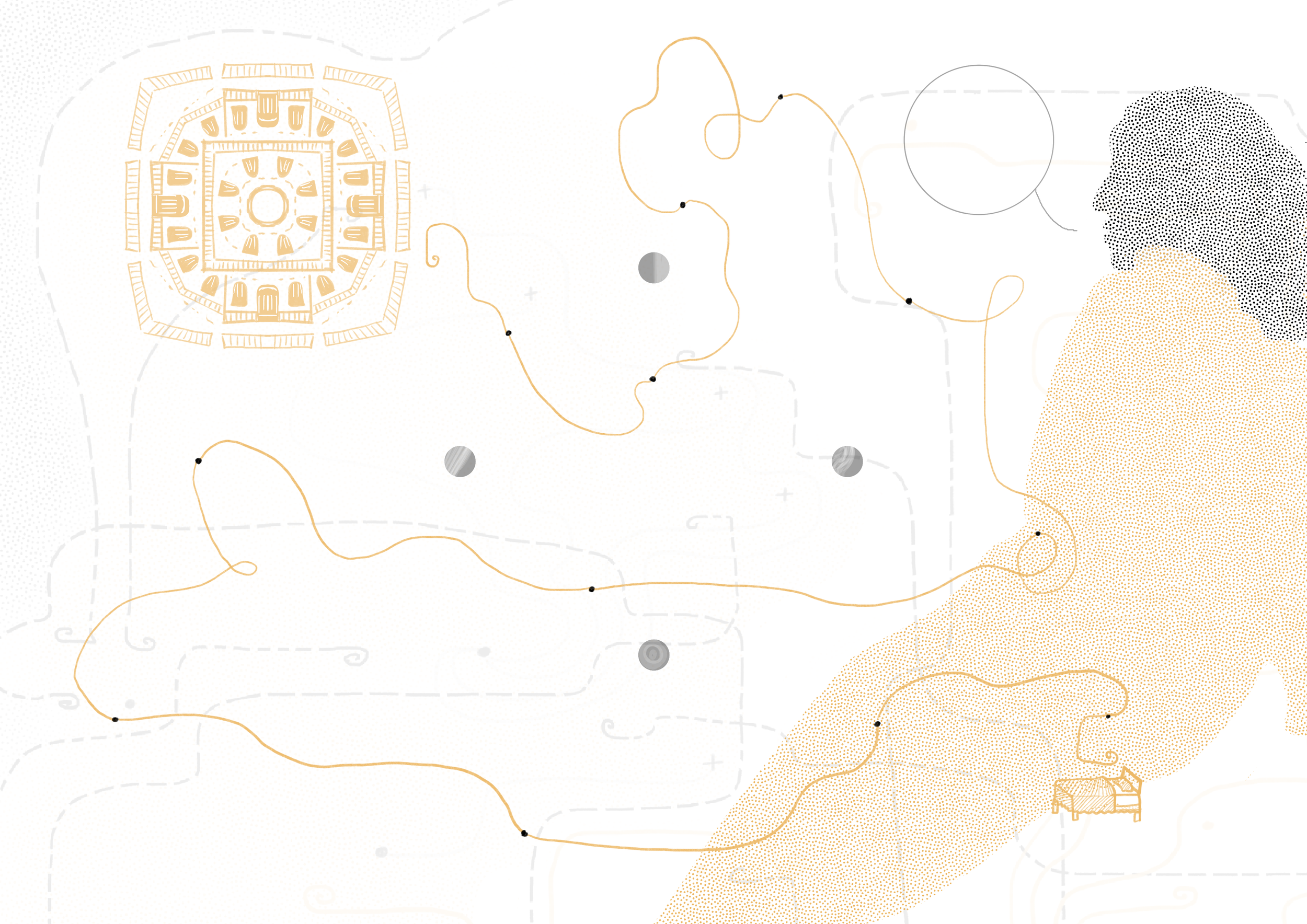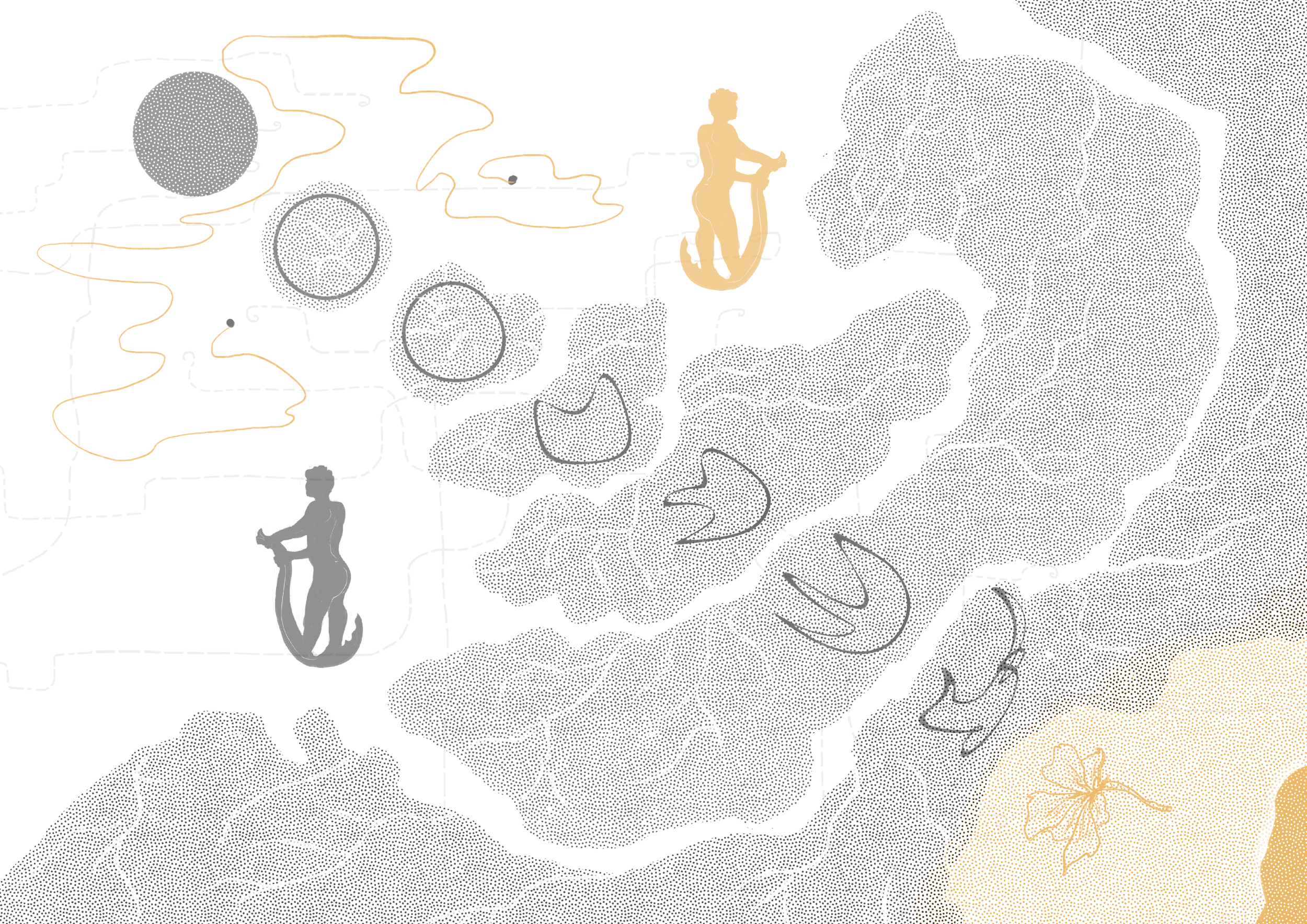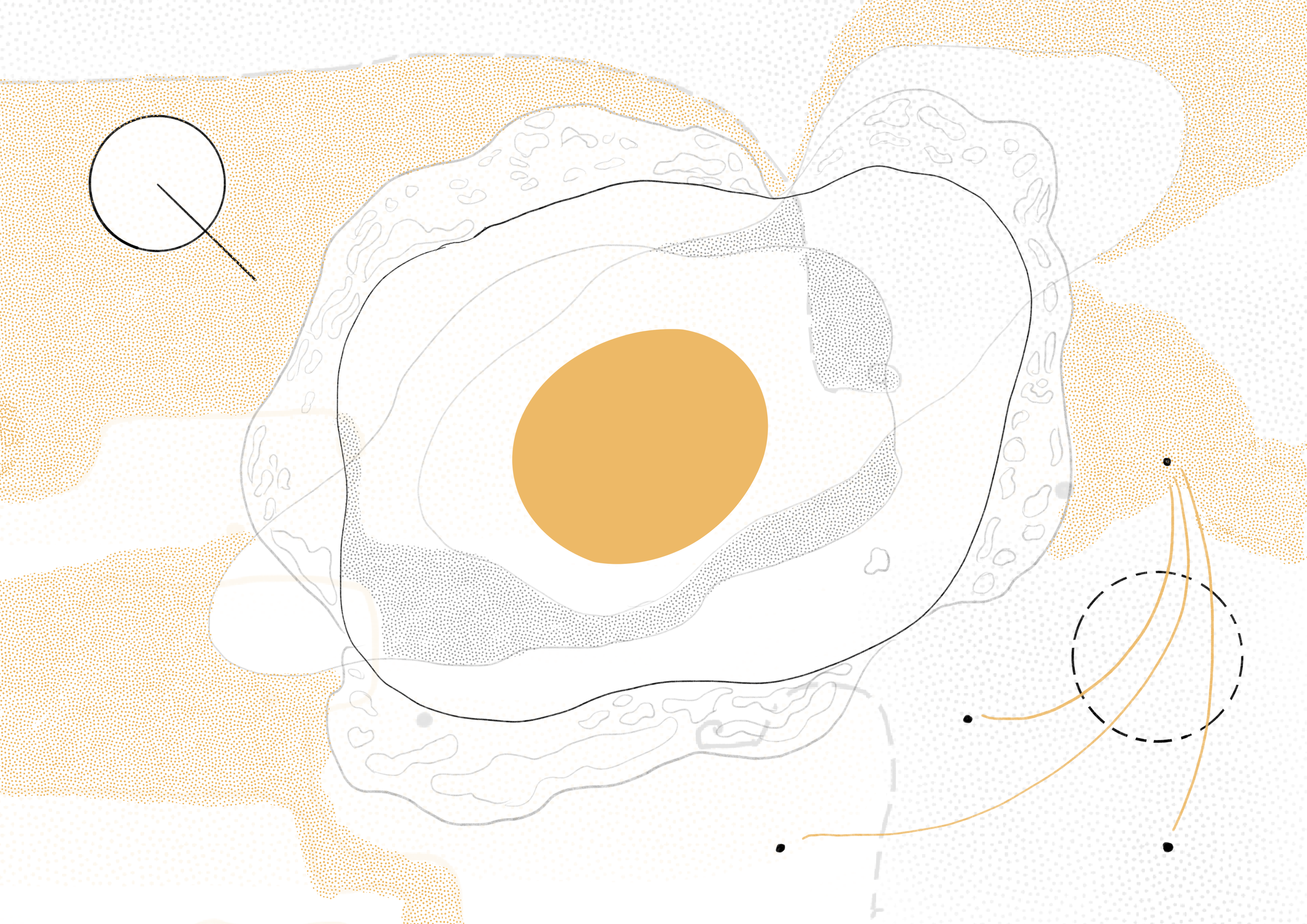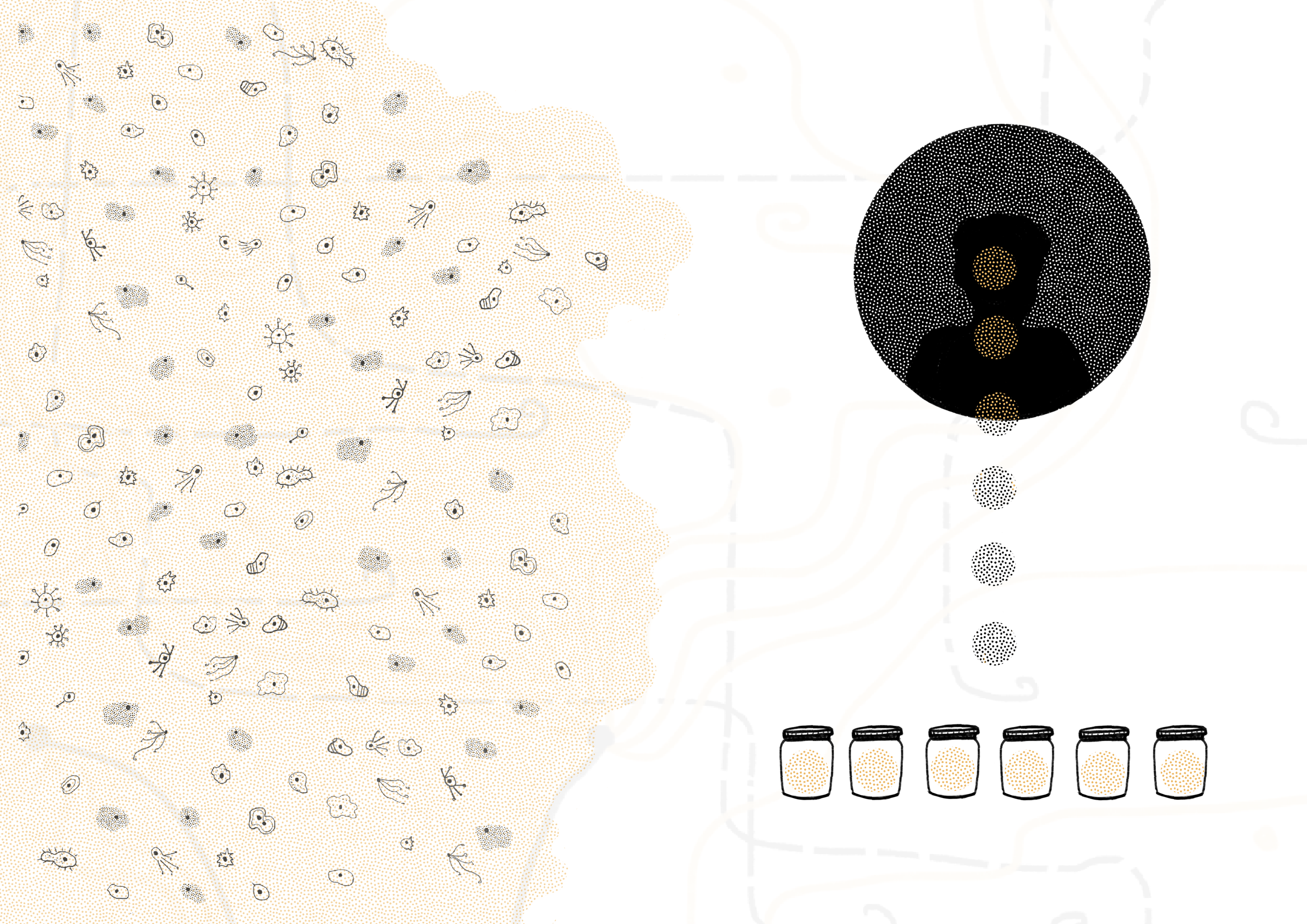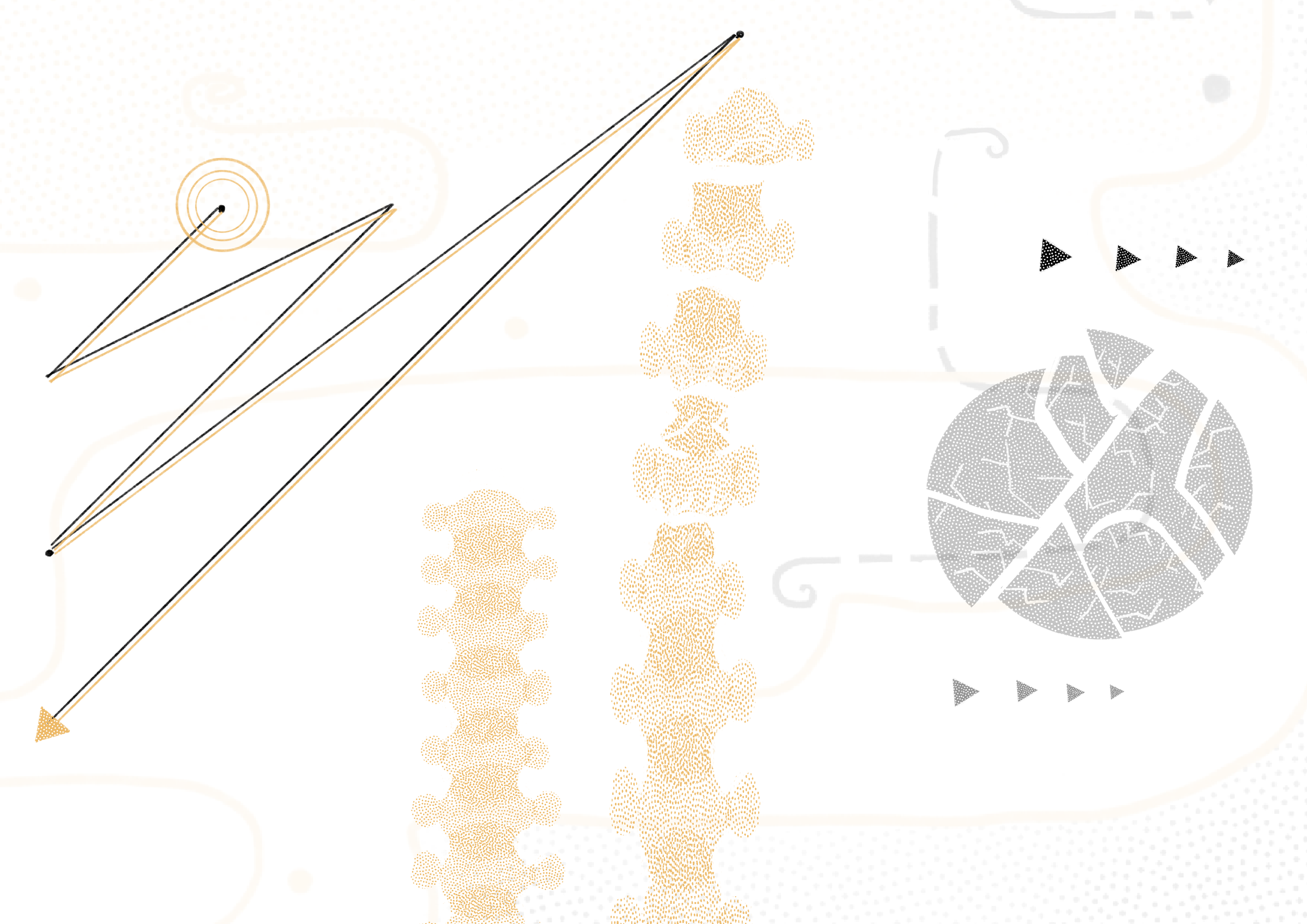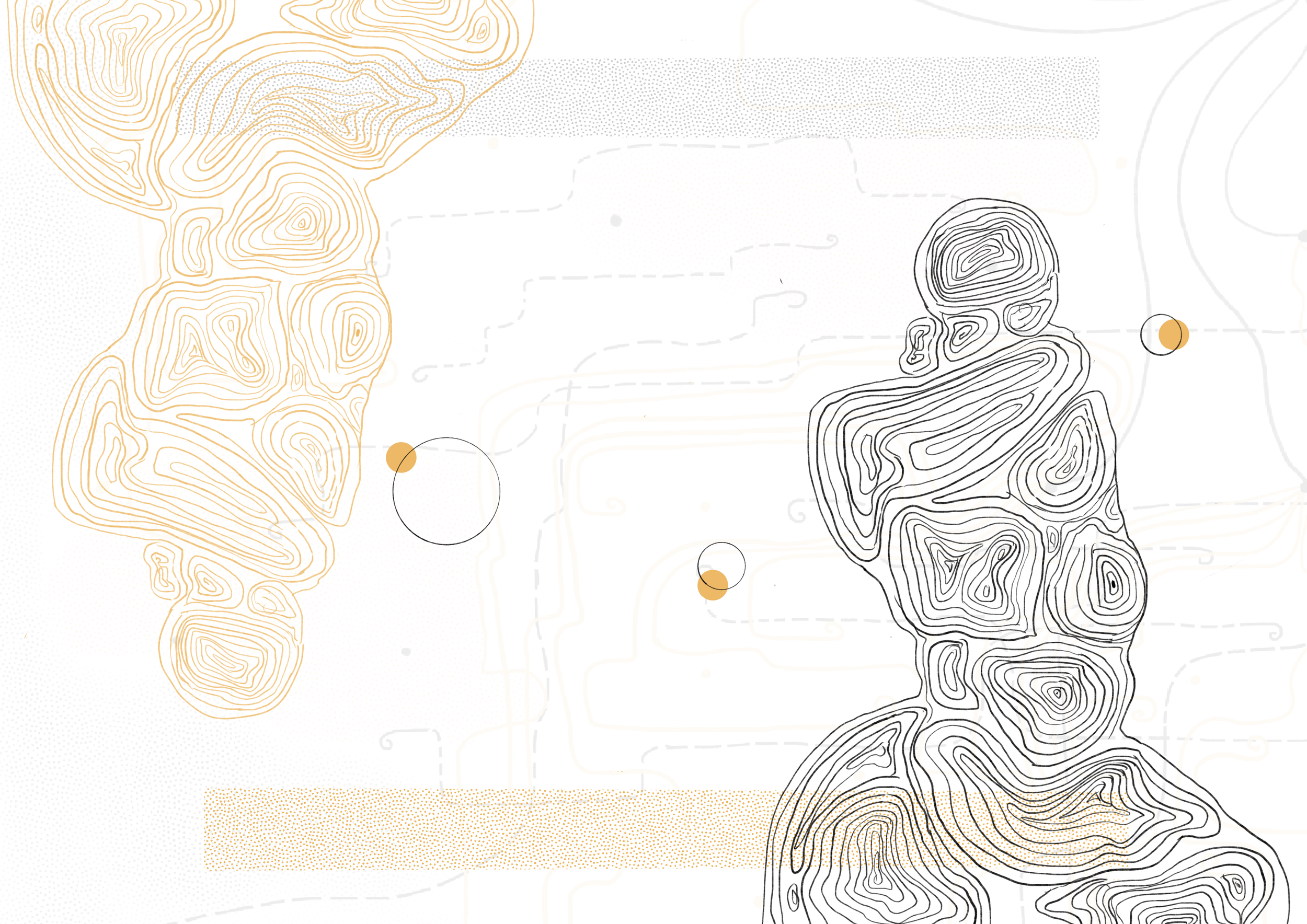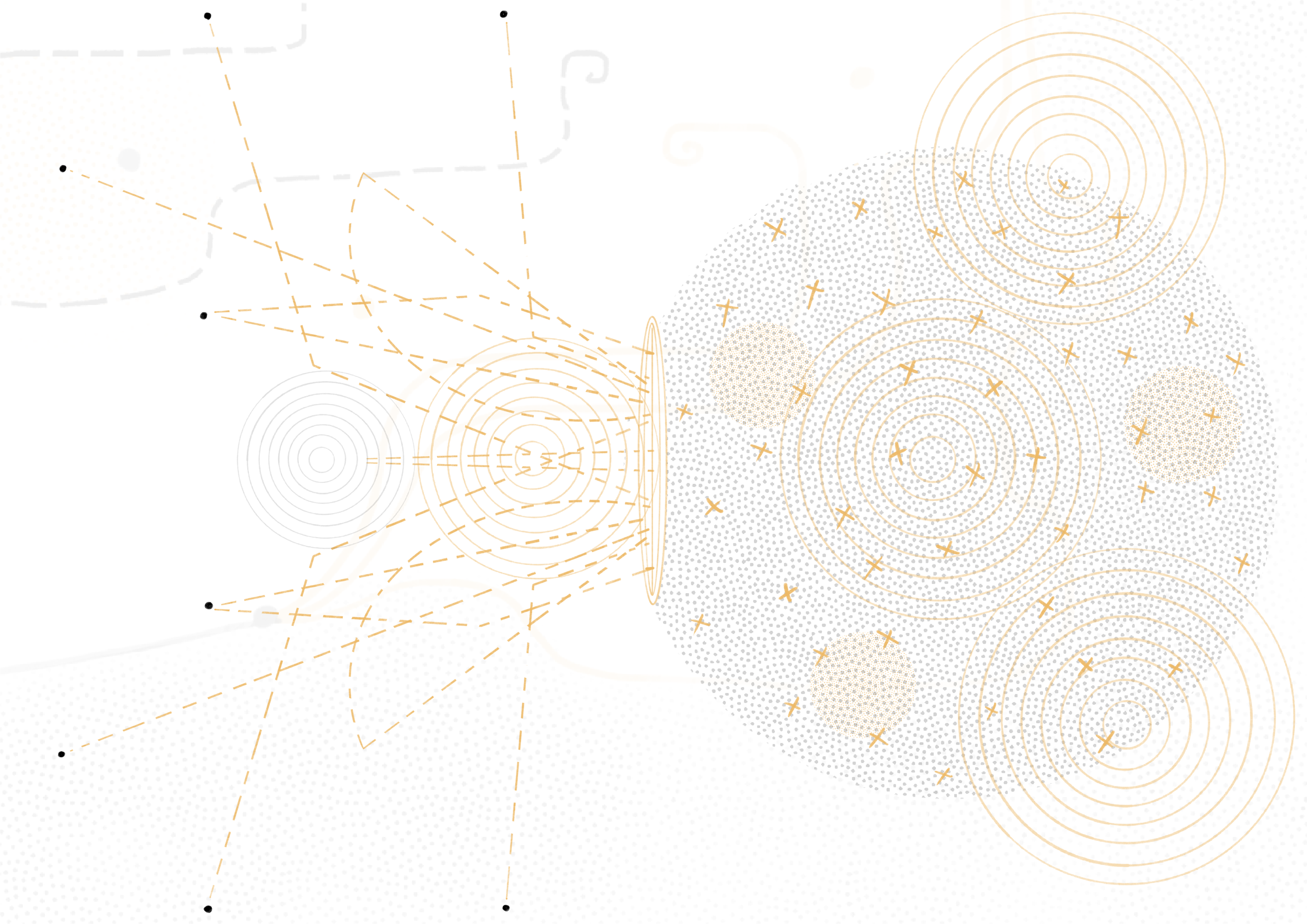Of the Unexpected and the Ordinary
SANYUKTA SAHA AND VRINDA MISRA
“Mera birthday thha, par boring thha. Hum birthday nahi manate na.”
“Aankhein band karti hoon to chinta hoti hai.”
“Jab ghar mein thhi aur yaha bhi aa rahi thhi, tab uljhan mein thhi, ab khush hoon. Khelke aur dance karke maza aa gaya.”
“Isne late kara diya - hair style banane lag gayi, apne banaye phir mere banaye.”
“Oye! Sunn! Face colour dena! Face colour!”
“Mere naam ka matlab jo farishta hota hai, uski wajah se ghar mein na kabhi ladai nahi hoti. Par mere ghar mein toh phir bhi ladai hoti hai.”
(It was my birthday but it was boring. We don’t celebrate birthdays na.
When I shut my eyes I worry.
I was in turmoil at home, and even as I was walking here. Now I am happy. I had fun playing and dancing.
She made me late - she was creating new hairstyles - first for herself and then for me.
Oye! Listen! Give me face colour! Face colour!
My name means “angel” - they say because of this name there won't be fights at home. But, nonetheless, there are fights at my home.)
“The last thing I expected” or “sudden” evokes the sense of a jerk, like sitting on the last seat of a DTC bus, right above the vehicle’s tyre, and the driver pushes the brake, and the head and the body are thrown off centre — opposite to each other. It lasts for a moment, and is a small movement. What if ordinary living was a series of these moments and movements that destabilise you, woven in and layered with each other across time and space. When life is systemically a series of happenings that throw you off, suddenness acquires a quality that is pervasive, invisible in its constancy, and slow.
This paper is located in the observations and processes of work within Aagaaz Theatre Trust. The organisation is an arts-based not-for-profit located in New Delhi. The primary site of Aagaaz’s long-term community-centred performance and applied theatre practice has been Hazrat Nizamuddin Basti. Sanyukta began engaging with primary years students here in 2009, and many of this group of children are now young adults who are theatre practitioners and artist-facilitators, and continue to work with children and adolescents in the neighbourhood as a part of the organisation. Aagaaz aims to create spaces of curiosity, imagination, creative expression, and dialogue, to question “what is” and discover “what could be”. Vrinda has been volunteering her time as a mental health support practitioner for one of the founding members of the group since 2018, and has been a member of Aagaaz’s Facilitator’s Collective since 2021.
Here we work through the beginnings of a long term engagement with a group of six adolescent girls from the neighbourhood. This paper is based on the first ten sessions of this process between March to May 2022, and the longer connection with Hazrat Nizamuddin Basti — a place that constantly defies any attempts to capture it as a grand narrative. The group is at a precarious intersection between many identity groups that are systematically ignored — a group of adolescent girls that live in an area classified as a Muslim ghetto. The everydayness for this group is a series of destabilising experiences. This ordinary is what informs the selfhood of the individual. Veena Das says, ‘there is a mutual absorption of the violent and the ordinary ... so that the event is always attached to the ordinary as if there were tentacles that reach out from the everyday and anchor the event to it in some specific ways”. [1]
Muslim ghettos in Delhi defy homogenisation. Each of them are specific in the shape of their public spaces, cultural mores, inter-relationships with each other, and neighbouring areas. The complexity of Nizamuddin Basti is intensified by its location. It’s located at the corner of a bustling intersection of Central/South Delhi, flanked by the very upmarket neighbourhoods of Golf Links, Nizamuddin East, Jangpura Extension, Sunder Nagar, Lodhi Road, Jor Bagh. Each of these areas is accessed by the inhabitants of the Basti for employment, religious practices, education, health services, and leisure. The experience of the stark contrast between these areas and the Basti is visible to anyone moving past the neighbourhood. So much so, that during the Commonwealth Games, the government attempted to block the view of dignitaries from Lodhi Hotel (the Aman Hotel) by putting up gigantic hoardings that displayed pun-ified adjectives of ‘Delhi’ such as “Delhi-ciously yours”, “Delhi-riously yours”, and “Delhi-ghtfully yours”.
The people that live in the Basti are varied in their relationship with the city — the seven mohallas are almost like seven different worlds densely packed together. Kot Mohalla is home to some families that identify themselves as the descendants of the great sufi saint Hazrat Nizamuddin Aulia, and the guardians and caretakers of the Dargah. The rest of the Mohallas are home to first-generation migrant families divided roughly according to the various regions of the country — from far east, Bihar, to the northern belt that the residents come from. Even though the area remains a much visited tourist destination with the Dargah, Ghalib’s Mazaar, Chausath Khamba, and its epicurean offerings, there are gaping holes in access to services and infrastructural resources that the residents experience in their everyday life. This is in common with most Muslim ghettos across the country, and as Anjali Bhardwaj Datta identifies, has roots in the “re-grouping” that occurred during the partition She adds that there was “[...] marginalisation of the community because ghettos become the sites of suspicion. This classification had other serious implications too — it denoted the estrangement of Muslim localities, and their neighbourhoods, from the rest of the city. The subjective sense of closeness among the residents of these neighbourhoods, and their neglect by authorities, translated into a lack of infrastructure, educational facilities and other amenities.” [2].
As we set out to build the foundations of adolescent support circles in the neighbourhood, we held several questions. Where do we begin? What would help the group to feel safe? How do chronic stressors and structural violence such as poverty, Islamophobia and patriarchal oppression among other factors impact the girls of this neighbourhood? In the same breath, how do our positions of privilege and therefore relationship with space, shape our understanding of the layers and intersectionalities of identities that the members of the group carry? How do we hold the awareness of these power hierarchies that exist, and place ourselves in a way that can assist opening the space to questioning these huge imbalances?
There are, of course, no easy or clear answers. We expected the questions to deepen as the long-term work with this group unfolded. We approached the group and ourselves with curiosity – what shift can the slow and consistent engagement with the arts create in the response to this ordinary experience of the unexpected? Our sessions were anchored in the aim of collective space-making. We set out to work with the arts as therapeutic practice and investigate the role of well-being in processes of social justice. Our intention was to create a space for the group to witness and be witnessed. To play with the pushes and pulls of individual and collective identity. And through this play, to develop new relationships and resonances, with each other, the space and ourselves.
Fundamental rights and the dignity of existence are at the core of a feeling of safety that creates a sense of well-being. This leads to resilience — economic, physical, emotional, intellectual. Resilience provides access to be able to respond to crises from a place of resourcefulness. However in its absence, people find themselves against the grain of systemic decision-making and every aspect of their life including its possibilities can stand diminished and compromised. Given their age, gender, religion and social class, the members of this group are especially vulnerable to chronic exposure to traumatic stressors. Therefore, in our work, it became important to employ a trauma-informed lens. The nature of trauma itself is overwhelming and its memory is not a singular story — it comes back as fragments of images, sounds, body sensations and intense emotions. In his book, Complex PTSD – From Surviving to Thriving, Pete Walker describes a multi-layered response to abandonment trauma. Over the course of our work with the group, we made several observations of trauma responses playing out at somatic, emotional and relational levels. [3]
As artist-facilitators and writers of this piece we hold consistent intention to hold contradictions — challenging any impulse to homogenise, while aligning with research on psycho-social and applied arts methodologies. While we write about trauma and building resilience, we identify both as categories that inhabit a spectrum, and aren’t fixed. The sample of experiences with the group was 15 hours of engagement and our observations are pegged in small moments and responses — verbal and somatic. Our intention has been to access the imaginal, which is to tap into a reservoir of infinite possibilities — in the body during somatic work, in projection while transforming objects, and piecing together internal resources that can build resilience- as a collective exercise.
As the process with the group continues with different facilitators and new members, we documented some of the themes that began emerging as we set out to do this work.
Achanak! Bimari.
We made a tree together. The tree would represent our way of being together as a group. Everyone drew parts of the tree and wrote things about the group that made up those parts. While drawing the trunk, there was a lot of desire expressed by Sumaiya and Nazia that everyone should show up and that it would be so very important for all of us to commit to coming together on time so we could all play. “Sabko aana chahiye. Tabhi mazaa aayega. (It will be fun only when everyone turns up.)” They didn’t turn up at the next session. That day we played ‘Yeh pencil, pencil nahi hai…’ (this pencil is not a pencil…), which is a game where an ordinary object is transformed in terms of its shape, size, utility, ability and context using spontaneous expressive forms of imaginal play. Sumaiya, who has been one with an advanced ability to access imagination and playfulness, transformed the pencil into a walking stick; ‘budhaape ka sahaara’ (support for the aged) and a witch’s broomstick; ‘voh jhadoo jispe udte hain,’ (flying broomstick) left the session feeling energised and joyful. Both Sumaiya and Nazia had family members fall ill after this and dropped out unexpectedly just when the group was beginning to become an entity of its own.
Despite all the measures taken to ensure grounding and stability, the space was a viscous, fluid thing. Almost like a fried egg that would begin to coagulate and take shape but then not, not quite. Uncertainties kept finding their way in and we found ourselves swimming in amniotic waters. This egg remained runny.
Facilitator’s sensorial response post session 3
In order to begin to understand the needs of the group and to design an effective overall engagement plan, we needed to hold in awareness the multiple layers of complexities embedded in the environmental context.
Disease, both chronic and pandemic-related, regularly disrupted their lives and affected regularity of attendance during this process. There is a prevalence of kidney stones, typhoid, jaundice, as well as nutrition deficiencies. To add to this, during what would have been week six of our work together both of us (the facilitators) also fell ill with Covid-19. Physical illness has been one of the key complexities which contributed to the uncertainty of attendance which in turn affected the time it took to develop a sense of safety and stability in the group.
We also noticed that several of the girls are instrumentally parentified, due to which they end up playing the role of little mother to their younger siblings, which affects their ability to make it to the group and also their energy levels within sessions.
Apart from illnesses, the summer heatwave and observation of Ramadan during this time affected the way the group showed up as well. Many of the girls would report feeling fatigue, saying, ‘aaj Roza lag raha hai.’ They wanted to stay seated and spoke less. Sometimes the space would feel like an oasis in the desert. ‘Aaj khelne ka mann hai?” (Do you feel like playing today?) “Kuch baithe baithe khila do.” (Make it a game that we can play sitting down) “Aaj break lena hai kya?” (Do you feel like taking a break today?) “Nahi, Yaha aake sukoon milta hai.” (No, it feels relaxing to be here.)
Before every session we sent out a message asking ‘aaj kaun kaun aayega?’ (Who all are attending the session today?) These enquiries began to find their place as creative invitations by the group to all its members. At the same time, they further added a layer of looseness and permission to either attend or not — keeping the amniotic fluid texture of the group alive at all times.
An ‘aaj kaun kaun aayega’ invitation
A full group before the heatwave and Ramazan.
Achanak! Blank!
Of Systemic Trauma and the Freeze Response
The group was in the process of creating a six-part story. The six piece story-making tool is used for therapeutic assessment of a person’s methods of coping through stress and gives insight into their strategies of resilience. As part of this exercise, the group was instructed to draw on paper. The crayons and paper immediately brought up fear for a few in the group. Every now and then we heard refrains of “Accha nahi ban raha.” (It’s not looking good), “Kya banau?” (What should I make?), “Color bhi kar sakte hain kya?” (Can we colour as well?), “Mujhe drawing nahi aati.” (I cannot draw).
Tracing the moments of freezing:
Tentativeness to offer new ideas in story-building games. Risk averse ideas.
“Color bhi kar sakte hain kya?” and “Mujhe drawing nahi aati.” — came up right in the beginning as we set up the six-part story exercise. It was a moment for us to anchor that the material and the exercise was bringing up fear and self-doubt.
The amount of time they would spend on an exploration.
We played a common drama game called 1-2-3, where in pairs players count from 1 to 3 alternately taking turns. Each number is replaced, one at a time with an action-sound, until all the numbers are replaced. In a couple of attempts, we heard members of the group say —
“Ho gaya” (We’re done.), “Ab kya karna hai?” (Now what do we do?) ,“Bore ho gaye karte karte” (We are bored of trying). When we spoke about what the boring thing was — the group shared how they experience their own ideas being boring when a task seems too challenging — the fear of "Mujhe nahi aata" (I don’t know.), “Nahi aata isiliye boring lag raha hai” (Don’t know how to do it, so it feels boring), and "Kaise karna hai?" (How do we do it?)
During our reflection as facilitators, we decided to focus on a process of play over product-making approach.
We introduced clay play — the game was, just that — to play with clay, but without using fingers and palms. Just playing, not making.
In a moment, Reshma quipped — “Accha nahi bann raha” (It’s not looking nice), “Kya banao? Rose banaaoo?” (What should I make? Should I make a rose?), “Achaa nahi dikh raha” (It’s not looking nice). Kulsum and Shaista slowly made the decision of pausing, slowing down, challenging the known ways of doing. Kulsum, aged 12, is the youngest member of the group, also a part of the children’s group at Aagaaz, found it easier to let go, giggling and giving in to exploring working with clay using many body parts. Reshma made two roses, gifted one each to us. We graciously accepted the gift. She smiled and said, “Mujhe rose banana achha lagta hai.” (I like making roses.).
For one of the sessions, we planned to play with crayons — just letting the colours make shapes, make drawings with our eyes closed, to let go of the sense of control over what is being created on paper. Here’s a snippet of the exercise:
One of the key emergent themes as part of the first ten sessions was self-doubt. Do I own the space? Can I belong here? What can I do in this space? Is that the right thing to do? As facilitators, we decided to create more space and time to get into play mode with material before going into deeper engagements. We made play the objective — as play allows us to access parts of ourselves that suspend judgement, and our familiar ways of recognising ourselves and others. This remains an integral part of the objectives for the work with this group that continues.
Clay Play at the Aagaaz session. Just playing, not making.
Achanak! Sawaal
Imagine a wire strung taut inside the belly. Holding you back from behind the navel. You lurch forward a bit, it tugs you right back. Too dangerous. Thereon ensues a series of tentative lurching backwards and forwards. What is allowed, what is not? Can I draw here, on this? Don’t be stupid! In any way I want? Am I allowed? In any way? You sure? Okay, then…
From a trauma lens, in the absence of safety you can’t be curious and you can’t act. So, in order to sense the presence (or absence) of safety, we recorded moments of action (or inaction) and micro-moments of the emergence of agency.
Flashback to when Shaista walked in tentatively, followed closely by Reshma. They maintained close proximity to one another, finding safety in each other’s arms and located themselves in the corner of the room. Reshma would look down a lot and make eye contact only when she wanted to say something.
There was a small moment of movement during the six-part story-making exercise when Shaista suddenly had a wave of inspiration. As soon as she hit upon an idea, she picked up her material from beside Reshma and moved briskly to another spot to secure her own space to work in. She responded, to our surprise, with a glint in her eye and a spring in her step.
Another day while we were exploring an exercise called ‘Haal / sawaal / khayaal,’ (Feeling / question / thought) something else began to move. In this structured sharing exercise we would close our eyes and pick up a little pebble. Our sharing would depend on the colour of the pebble. Red meant we would share feelings, green was for questions and yellow for thoughts. Shaista picked up a green pebble and asked, “hum natak banayenge kya? Main ek baar pehle performance mein thi.” (Are we going to make a play? I was in a performance once). Expressing this desire to be on stage and perform was the beginning of a slow shift, she started showing up to sessions each time and every time she would take up more room with her body, her eyes and her voice.
One afternoon Afreen, who generally came across as quiet and present, was early and took the opportunity to break her silence by asking Nagma and Nagina — who are founding members of the Aagaaz Repertory, “Aagaaz kya hai?” (What is Aagaaz?)
Nagma shared with her, “pata hai, agar Aagaaz nahi hota na, toh abhi tak…” (I don’t know, but perhaps if I wasn’t in Aagaaz, by now…) “shaadi ho gayi hoti…” (you would’ve been married off) Afreen added, finishing Nagma’s sentence for her.
The curiosity about the space showed up in other ways too. For instance, after our time together as a group would be over, Shagufta would hang back and stay to explore the books in the library. She brought up the theme of belonging often in her sharings. “Mere zyaada dost nahi hain.” (I don’t have too many friends). As the weeks passed, the nature of their curiosity shifted from being focussed on us, our bodies and our otherness:- “Aapke baal safed kyun ho rahe hain?” (Why is your hair greying?) “Aapki shaadi ho gayi?” (Are you married?) “Aapke gale mein yeh kya ho gaya?” (What’s happened to your neck, there?)
We observed moments of explorations in finding a sense of belonging in the group. “Aaj aur log aayenge?” (Will more people turn up today?), “Ab kiski baari hai share karne ki?” (Whose turn is it to share now?).
These explorations looked like tentativeness from a distance. They started to explore each other with what could be perceived as a more tender approach.. Towards the beginning we would notice the tendency to rough handle each other’s bodies as though the partner were an inanimate doll and take liberties with each other that stemmed from familiarity and from the ethos of the other spaces that they occupied together, such as school and tuition classes. They would often interrupt each other, answer on behalf of and pass sarcastic remarks about each other.
There was one particular moment when Reshma and Iram were partners in a sculpting exercise, during which Iram noticed how tired Reshma was feeling and sculpted her into a supine position of rest. The manner in which she handled the body was much slower and more attuned to the other as compared to earlier body based interactions.
Sensing and sculpting…into rest
This ability to tune in and listen to the spoken and unspoken messages floating in the room has been a two steps forward, one step back sort of dance, where on one day someone yells “PAUSE!” — the group’s safety word, because they noticed that someone was being interrupted by another member of the group, and on a day when we have been conversing about letting the body follow its impulses, someone asks the question right before leaving, “acha…vaise kya aap mujhe bataa sakte ho ki motapa kaise kam hota hai? Matlab, patle hone ke tips hain aapke paas?” (So… can you tell me how to lose weight? I mean do you have tips on how to lose weight?)
Achanak! Group ka haal (behaal)
Hum dance nahi karte. Park mein dance karo toh koi bhi ammi-papa ko jaa ke keh sakta hai, tumhari ladki ko dekha hai? Kharaab ho gayi hai. (We can’t dance. If we dance in the park then anyone can go to our parents and tell them — Have you seen your daughter? She is not a good girl anymore.)
During one of our last sessions with the group, we encountered a moment of conflict in the group. Shaista and Kaifulwara (who had recently joined the group) disagreed about dancing in public. While the latter thought dancing is a private activity and one needed to be mindful about parents’ reputation, the former thought dancing is a response to music and any place can become a dance floor.
The views were strong and came up just as we were closing the session. We worked toward creating a space where we could all just listen to different perspectives, it felt like a bandaid. How does a group hold conflict?
In our sessions with the group, the narrative was non-linear. Just the day before this heated argument over dancing, we found ourselves unable to take photographs because we danced! All of us. Dancing wasn’t what we had planned for — we were doing an exercise on sculpting and there was music playing as a stimulus for the exercise. In a spontaneous moment during this exercise, Shaista and Kaifulwara started dancing, and without the bat of an eyelid all of us joined in. We made the music louder and gave into the flow. As facilitators, the possibilities of a space of leisure and play couldn’t have been better articulated through bodies. Bodies in sync can perhaps move on impulse without effort. What created this sync though? How does one anchor these tiny shifts in a group’s being? Was the ability to disagree with one another on this day a function of being in sync the day before? What is the relationship between community and conflict?
A moment before the dancing began
Some members of the group were running late one day. Shaista, Iram and Kaifulwara were already there. While we were waiting for the others, we were playing a game of hackey. Shaista kept getting agitated because Reshma hadn’t reached yet. “Voh nahi aayegi, usko aana hee nahi hai. Pataa nahi kahaan hai.” (She isn’t going to come today, she don’t want to come. I wonder where she is.).
Shaista and Reshma share an intimate friendship and as is often the case in such relationships, they bicker. The rest of the group would also often catch on and add to making similar comments about each other. What is the role of irritation, frustration, disagreement, and conflicts in processes of change?
Towards the end of one of the sessions, we asked the group to find a song that reflects their hopes for the group. The song 'Yaar teri yaari, umar sari' emerged as their choice.
As facilitators, we held on to the contradictions that kept emerging. We prompted each other to remember this is a long term process with the group — we don’t necessarily need to “fix” behaviours and patterns, but trust the space we were created and the intelligence of each person in the room to adapt and deepen their relationship with themselves and with each other.
Concluding Notes
In her essay, ‘The everyday as an enactment of the trauma of being a Muslim woman in India,’ Shaheen Salma Ahmed writes “of the many levels of identity, the one that has become the dominant identity is this pre-supposed notion not just by the hegemony but among Muslims themselves, of who a Muslim woman should be.” [4]
There is a complexity in working continuously with children and young people in Hazrat Nizamuddin Basti, and perhaps anywhere. Being present to a participant as drama-based facilitators creating safe spaces makes us aware of the unique personality that each participant brings. The being of these personalities often challenge the identities ascribed to them. Working with groups, we recognise the social structures of age, gender, class, caste, religion, etc. makes a person. The uniqueness of the individual is a function of the multiple layers of their identities as well as aspects that are intrinsic, dynamic, and harder to anchor in a category. There is a constant push and pull between the individual and the collective. As we facilitate processes of community-building, we deepen our understandings of a socio-economic category, a neighbourhood, a person, each becoming pegged more in questions rather than statements. There is hope in embracing a growing un-knowingness as a reminder of the possibility of another milieu becoming a spectacle to our gaze.
The work that we write about here was just the beginning of what is and will remain a part of Aagaaz’s sustained engagement with this group that has grown to about twelve young girls as we write this article. Our observations and inferences are efforts to delve deeper into a process of embodied experiences — of drama-based work, and the lives that are lived beyond the workshop space. Long-term engagement denies the satisfaction of clean and finite outcomes — it means that the land beneath our feet continues to feel like shifting sands. We can truthfully only document observations and moments of micro-change. The narratives and change stories are identified by group members over years — we are beginning to find those with the current repertory members after thirteen years of intensive and continuing engagement.
When we started toying with the plans of working with a group of girls in their adolescent years, we had ideas about how this group may behave, the resources we must have to facilitate this process, what we may explore and create during these sessions. Our experience though was predictable. With each session we found ourselves purging ourselves of expectations and certitudes — of ourselves, the plans, and the group — a thread at a time. We started with many questions about how the context of the girls’ lives may impact the work we do with them, and each session further kept opening up new dimensions and questions. Our conversations were rooted across the spectrum of emotions, and as facilitators we tried to hold each emotion, question and thought with a sense of lightness.
We are curious about the role of building a sense of community within this group. This group of girls makes time twice, sometimes thrice a week, to remember and embody play, unfamiliarity, courage, in a space that offers a safe temporary alternative from an environment that continuously stands in the way of them thriving as people. We wonder if female solidarity will develop within this group, and if this will shift the trajectory of their lives. As we watch from a distance the work with this group unfold, now held by four facilitators from Aagaaz - Pakhi, Subhadra, Nagina, and Grace, this space of leisure and play seems to have already created a sense of commitment and seriousness in the participants.
As we conclude this article, we go back to the idea of the possibility of being in new ways. While the gamut of survival adaptations such as freezing, avoiding, becoming pleasing and dissociating are all observable in the group, they co-exist with resilience both old and emerging. While survival is absolutely necessary, can this space foster the thriving of other parts in the long term? Perhaps of parts that have the resilience to imagine, challenge, play and be in new ways? Perhaps just like in the moment of this interaction on a WhatsApp group with the participants and facilitators, used for ease of communication.
In a rare circumstance, one of the facilitators wrote to the group 30 minutes before the session :
“Hello doston aaj aapka session nahi hoga.” (Hello friends, today your session will not take place.)Nasreen, wrote in response to that :
“Q” (to signify kyun - why?)
While at Aagaaz, we work hard at creating spaces where everyone is able to ask questions — we are also very aware of the power that each of us brings into the room. We are fundamentally unequal, and some need to work harder than others to ask questions — not just because of the power of the facilitator in the space - but also what this older middle class facilitator signifies. In the writing of that one single alphabet — “Q”, achaanak, there is questioning of authority, achaanak there is a micro moment of instability — the body of this young girl is grounded, the status-quo quivers in rehearsal of the possible challenges that the girls may throw at society in their everyday lives.
A moment of solidarity
REFERENCES
[1] Veena Das, Life and Words: Violence and the Descent into the Ordinary. Berkeley: University of California Press, 2007
[2] Anjali Bhardwaj Datta (2021) Nation and Its ‘Other’ Women: Muslim Subjectivity and Gendered Agency in Delhi, South Asia: Journal of South Asian Studies, 44:2, 380-397, DOI: 10.1080/00856401.2021.1887994
[3] Walker, Pete, Surviving to Thriving. Lafayette, California, Azure Coyote, 2013.
[4] Anhmed, Shaheen Salma. "The everyday as an enactment of the trauma of being a Muslim woman in India." Islam, Sufism and Everyday Politics of Belonging in South Asia, Edited by Dandekar, Deepra and Tschacher, Torsten, Routledge, 2016, pp. pages.
Sanyukta is an applied theatre practitioner and works with Aagaaz Theatre Trust. She is curious about looking at the relationship between theatre, activism and mental health and well being.
Vrinda is an applied theatre practitioner who works using the container of artistic mediums (such as drama, movement and visual arts) in therapeutic and learning oriented contexts. Her practice leans on a feminist lens and uses approaches that are embodied and trauma informed. She has spent the past decade working with groups and a lot of her time during these pandemic years as an emotional well-being facilitator. She is enthusiastic about dancing,illustrated memoirs and finding magic in what feels like the ordinary.
